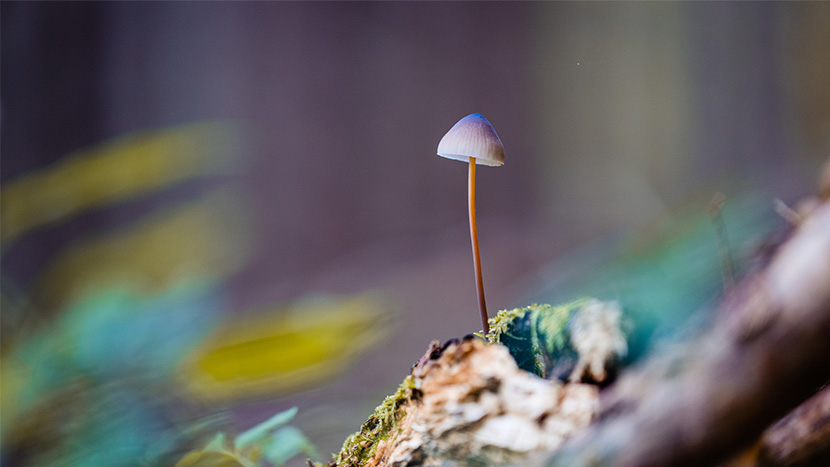Why Do Some Mushrooms Have “Hallucinogenic” Effects?
As you stroll through a lush forest, your eyes might be drawn to particular kinds of mushrooms. These aren’t your regular cooking ingredients. Instead, some specimens pack a lot more punch.
These are hallucinogenic mushrooms, little fungi with a formidable legacy. This naturally occurring psychedelic can send you on a journey inwards and beyond, leaving you hesitant whether to class them as friend or foe in the natural kingdom around us.
Now, before we get started it is good to note that some people don’t like to use the word “hallucinogenic” for fungi because it is more of a heightening of senses than a hallucination, but for the purpose of this blog we will use this term to talk about the effects these mushrooms have on our brains.
Introduction to Hallucinogenic Mushrooms
Hallucinogenic mushrooms have intrigued humans for centuries. They’ve sparked curiosity for their mysterious ability to disorient time and space perception. Native cultures especially have cherished these earthy marvels, using them as conduits for spiritual transcendence.
Unlike ordinary mushrooms, hallucinogens carry a potent mix of psychoactive compounds. These substances trigger profound alterations in the human mind. Consuming even a fraction of these fungi can trigger a cascade of thoughts and visions that seem out of this world.
In the next section, we’ll delve deeper into the scientific rationale behind this phenomenon. Let’s walk down this psychedelic path together and unearth some intriguing insights about these extraordinary fungi.
The Science Behind the “Magic”
Next, let’s unravel the scientific explanation behind these “magical” mushrooms. For starters, it’s essential to note that not all mushrooms are created equal. The hallucinogenic properties only arise in certain species.
These species of mushrooms contain unique psychoactive compounds that interact with our brain’s chemistry, primarily psilocybin and psilocin but also muscimol. These substances play a crucial role in provoking psychedelic experiences, considering they directly influence serotonin receptors in the brain.
To put it simply, these compounds heighten sensory input which results in perceptual distortions such as seeing vivid colors or experiencing time dilation. This is what creates those famous trip episodes popularized by many accounts throughout modern culture.
Special Focus: Amanita Muscaria
Now, if we consider a specific species for deeper discussion such as Amanita Muscaria, we encounter an interesting deviation. A detailed look at a comprehensive guide on Amanita Muscaria will introduce you to the specifics of this variant.
Unlike psilocybin mushrooms, Amanita Muscaria contains muscimol and ibotenic acid. These compounds act on different brain receptors than psilocybin does. They lead to more tranquilizing effects as opposed to mind-bending journeys.
A major reason why these mushrooms stand out amongst others is due to their distinctive appearance. The enticing red cap with white dots has found its way into innumerable folklore, adding further fascination for humanity’s relationship with hallucinogenic mushrooms.
A Close Look at Psilocybin and Psilocin
So far, we’ve explored the broader landscape of hallucinogenic mushrooms and even highlighted a distinct species with unique properties. But what if we zoom in a bit more? Are you up for a closer look at how psilocybin and psilocin shape these mind-bending journeys?
Firstly, it’s vital to understand that these compounds alter the chemistry of your brain temporarily upon ingestion. The changes result from their influence on the serotonin receptors which typically moderate our moods, thoughts, and senses.
Psilocybin, especially, behaves like serotonin once inside your system. This causes an overflow of signals swirling around in your brain – mostly affecting your mood and perception. This is the point where normal reality might take on some kaleidoscopic features. Indeed, it is this “extra” activity in your brain that gives you an experience beyond the ordinary.
The Role of Hallucinogenic Mushrooms in History and Culture
As we journey through the wild reel of hallucinogenic mushrooms, one thing is clear – these fungi are not just natural wonders. They also hold a significant place in human history and culture. Over the years, their usage has intertwined with spiritual practices, medical therapies, and at times controversial recreations.
Their presence in various indigenous rituals stands as proof of their historic importance. More modern usage ranges from personal introspection to therapeutic treatments for mental health issues such as depression and PTSD.
Wrapping it up, understanding why some mushrooms can alter our perception so drastically lets us appreciate them beyond their mystical reputation. Whether you see them as a fascinating example of nature’s diversity or as powerful tools for mental explorations heavily depends on your perspective.
Remember though, respect towards any potential power within nature is wise – especially when that power can send you on a psychedelic trip!


































































































